This book constitutes the thoroughly refereed post-conference proceedings of the 20th International Conference on Financial Cryptography and Data Security, FC 2016, held in Christ church, Barbados, in February 2016.
The 27 revised full papers and 9 short papers were carefully selected and reviewed from 137 full papers submissions. The papers are grouped in the following topical sections: fraud and deception; payments, auctions, and e-voting; multiparty computation; mobile malware; social interaction and policy; cryptanalysis; surveillance and anonymity; Web security and data privacy; Bitcoin mining; cryptographic protocols; payment use and abuse.
